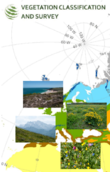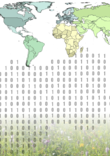Collections
We are pleased to announce the upcoming Special Collection on the vegetation of islands and archipelagos worldwide in IAVS’ gold open access journal Vegetation Classification and Survey (VCS). According to the scope of VCS, contributions either need to develop or to apply a vegetation classification framework of any type. For example, this can be a phytosociological classification system, the International Vegetation Classification (IVC), habitat types, formations, or biomes. We envisage particularly the following types of contributions:
- Classification of selected vegetation types occurring on islands
- Vegetation maps of islands
- Synthetic overviews of all vegetation types of an island or archipelago
- Conservation assessment of vegetation types of an island or archipelago
- Quantifying vegetation change in terms of turnover of vegetation types
Apart from Research Papers, also Reviews and Syntheses and Forum Papers as well as Long Database Reports and Nomenclatural Proposals are welcome. All contributions are expected to address the peculiarity of the island situation.
Procedure and deadlines (EXTENDED):
- Until 28 February 2025: Please submit your (preliminary) abstract to Jürgen Dengler (dr.juergen.dengler@gmail.com). The abstract must follow the VCS Author Guidelines.
- Until 20 March 2025: Authors will be notified whether their planned work is eligible for submission.
- Until 30 June2025: Submission of invited papers, which will then undergo peer review.
- End of 2025 or early 2026: Completion of the Special Collection with the publication of an Editorial by the Guest Editors.
Please note that VCS is a gold open access journal where authors are normally required to pay article processing charges (APCs). Thanks to the generous support by IAVS, APCs for IAVS members from high- and medium-income countries are strongly subsidized, while IAVS members from low-income countries can publish for free. For submissions until the end of 2024, even lower APCs apply. If you therefore intend to submit the full manuscript still in 2024, please contact Jürgen Dengler to discuss a special arrangement (outside the regular deadlines).
We look forward to receiving your contributions and hope that you will join us in making this Special Collection a valuable resource for the IAVS community.
The IAVS Regional Section Latin America and the Carribean and IAVS’ gold open access journal “Vegetation Classification and Survey” are proud to launch a joint Special Collection dedicated to “Neotropical vegetation”.
Editors: Gwendolyn Peyre (Colombia), Bianca Andrade (Brazil) , Alejandro Velazquez (Mexico), Melisa Giorgis (Chair, Argentina)
Scope: The VCS Special Collection on the Neotropics aims at featuring vegetation works dealing with the different biomes present in Latin America and the Caribbean. The Special Collection will be arranged around three main complementary themes:
1 ‒ Vegetation data, distribution, representativeness and access
2 ‒ Vegetation description, analysis and classification
3 ‒ Vegetation management and conservation
Studies that encompass at least one of the themes from the perspective of vegetation classification/typology and/or ecoinformatics were eligible. The Special Collection aimed at providing the first comprehensive overview on the actual vegetation classification research across the Neotropical biogeographic realm. The focus is on “Research Papers”, “Reviews and Syntheses” and “Database Reports”, but also any other article type of the journal is possible.
Outline:
Asia is the largest continent on Earth, but also the continent with the most extensive grasslands. Enigmatic are the huge and diverse steppes in the interior of the continent, but there are also arctic grass tundras, alpine grasslands, alpine steppes, desertic steppes, subtropical savannas and a multitude of semi-natural grasslands created by millennia of human land use. Classification is an essential approach to make the huge diversity of different grassland types better accessible and comparable, both for basic research and applied sciences such as management and conservation. However, only few countries in Asia have a strong tradition in grassland classification. Moreover, the classification approaches vary strongly between and even within countries. Thus, it is currently hard to achieve a consistent scientific overview on the grassland types of Asia.
Thus on the occasion of the first Asian Grassland Conference 19-21 April 2022 (AGC; https://edgg.org/AGC), the Eurasian Dry Grassland Group (EDGG; https://edgg.org/) and the gold open access journal Vegetation Classification and Survey (VCS; https://vcs.pensoft.net/) would like to launch a Special Collection of articles dealing with “Grasslands of Asia” with a typological view. In agreement with the scope of the journal, papers should develop, test or apply vegetation typologies or present vegetation-plot databases or tools in ecoinformatics. Typological approaches at any spatial scale from synusiae via phytocoenoses and landscapes to biomes were welcome. We were open to any approach to classify vegetation, including but not limited to the Braun-Blanquet approach and the EcoVeg approach. We particularly encouraged studies based on extensive original data, but accept also regional and even local studies if they come from underrepresented regions or methodologically innovative. Contributions presented at the AGC were particularly welcome, but also papers not related to the AGC are possible.
Outline:
At the beginning of the 19th century, the African continent was mostly pristine and roaming with wildlife without boundaries. As the human population increased, pressure has been put on the natural resources available. However, Africa still has large areas with near-natural vegetation and wildlife left. The continent has a large diversity of plant and animal life with several biodiversity hotspots. In addition, the African continent has, in the Congo basin, the largest remaining extension of continuous tropical rainforest globally. Africa is part of three floristic regions (Palaeotropis, Palaearctic and Capensis), adding to the high diversity of the continent.
The rapid population growth and consequent land use changes make the African continent a hotspot of change urgently requiring more research. There is still a narrow window of opportunity to collect more baseline biodiversity data on natural and near natural vegetation as well as to monitor the long-term changes as a result of anthropogenic activities and climate change. It is therefore of crucial importance to conduct research on African vegetation and to publish the results internationally to assist in bridging the data and knowledge gaps that currently exist.
Scientific publications are a key part of every researcher’s work. However, vegetation surveys and synecological research from Africa are currently underrepresented in scientific literature, resulting in inadequate knowledge and data on the continent. Additionally, even when research is conducted by African researchers, their research outputs are currently grossly underrepresented in the international scientific space; both at conferences and in scientific publications. As a result, a lot of data is lost to the broader scientific community as it remains unpublished.
This Special Collection in “Vegetation Classification and Survey” focusses on distribution patterns of natural vegetation as well as the dynamics resulting from the increasing human impact. In agreement with the scope of the journal, papers should develop, test or apply vegetation typologies or present vegetation-plot databases or tools in ecoinformatics. Typological approaches at any spatial scale from synusiae via phytocoenoses and landscapes to biomes are possible. Particularly suitable are the following topics:
The ‘International Vegetation Classification’ (IVC) project aims at providing a consistent, systematic, and authoritative description and classification of the world’s terrestrial ecosystems. The IVC is based on the EcoVeg approach, which builds on the physiognomic-floristic-ecological classification traditions. As such, this approach shares a central philosophy with floristic-ecological approaches, such as the Braun-Blanquet approach; namely, that vegetation types should be constructed from field data in the context of ecological, dynamic, and biogeographic considerations. It also shares principles with structural-functional approaches that assess patterns of vegetation in the context of global ecological drivers. The IVC currently contains a comprehensive set of upper (formation) types and various continental sets of mid-level types, including North and South America, Africa and other parts of the globe. The classification is mature enough that it is now being applied to assess ecosystems at risk across regions and continents. But much work needs to be done to fully extend the classification at all levels around the globe and facilitate its role in supporting regional, national and subnational classifications and assessments.
For this Special Collection, we invite papers presenting detailed case studies, regional-continental studies as well as global syntheses. We also encourage papers dealing with methodological aspects and the integration of other approaches of vegetation classification within the framework of the IVC.
Procedure and deadlines:
• No new submissions possible anymore.
Palaearctic grasslands in the broad sense comprise a large diversity of vegetation types, many of them of high conservation concern. Sound classification systems of Palaearctic grasslands and other open habitats are needed as reference systems for conservation and research. On the one hand, large national and continental vegetation-plot databases in combination with new classification methods allow developing plot-based classification systems that are consistent over large spatial extents, thus overcoming the idiosyncrasies of the multitude of previous regional classification systems. On the other hand, there are still many regions in the Palaearctic with diverse grassland vegetation that lack any plot-based classification system.
For this Special Collection in collaboration with the IAVS Working Group Eurasian Dry Grassland Group (EDGG; www.edgg.org), we invite classification papers dealing with Palaearctic grasslands sensu lato, i.e. any natural and semi-natural vegetation type that is dominated by graminoids, forbs, dwarf shrubs, bryophytes or lichens. While we particularly appreciate broad-scale syntheses of grassland types over larger areas, we also accept regional studies from understudied regions. Methodological and conceptual studies as well as nomenclatural revisions of syntaxa are also possible. While the focus of the Special Collection is on plot-based classification, we are open to consider Forum papers that elaborate on higher level typologies, such as biomes, sub-biomes, formations or degrees of naturalness. Particularly appreciated are studies that demonstrate how sound grassland typologies can serve as useful tools in conservation, e.g. in red-list assessments.
Procedure and deadlines:
• No new submissions possible anymore.
Papers presenting vegetation-plot databases and other ecoinformatics data sources relevant for vegetation classification as well as concepts and methods for using these should be submitted to this section. They should be classified into one of the above categories (Research Paper, Review and Synthesis, Forum Paper, Report).
VCS has established a formal collaboration with the Global Index of Vegetation-Plot Databases (GIVD; www.givd.info). It serves as outlet for Reports on GIVD activities, Short Database Reports (1 printed page, no text except abstract, no references) and Long Database Reports (3–8 printed pages, up to 25 references). Both types of Database Reports comprise as core element the standardised GIVD Fact Sheet. Database Reports in general are only possible for vegetation-plot databases registered in GIVD. Specifically, Long Database Reports are offered to databases from Europe (including Turkey, Cyprus and the Caucasus countries) and the United States with at least 5,000 plot observations or databases with at least 2,000 plot observations, while the thresholds for Short Database Reports are 1,000 and 400 plot observations, respectively. The given thresholds are valid for databases that have joined the supranational databases EVA and sPlot, respectively, and are doubled for those that have not. Moreover, Database Reports will only be accepted from databases that have not yet published such a GIVD-edited report or which have, after a previous Short Database Report, at least doubled their content. Database Reports of subsets of regional or national databases that have already published a GIVD Database Report will not be considered. Submissions of Database Reports must be accompanied by a recent GIVD Fact Sheet, which can be obtained from GIVD. The title of a Short Database Report consists of the name of the database (as registered in GIVD; capitalise all words because it is a proper name), possibly followed by a subtitle or explanation after an en-dash. For Long Database Reports, the title also must contain the unchanged proper name of the database, but otherwise its arrangement is more flexible. Further format specifications and instructions for submission are available from the Section Editors or from GIVD.
This section includes papers focusing on phytosociological nomenclature. We encourage comprehensive nomenclatural revisions of major syntaxa, analyses of nomenclatural problems related with the names of wide-spread high-rank syntaxa as well as Forum Papers on general nomenclatural issues that are of interest to an international readership.
Further, this section publishes Nomenclatural Proposals (e.g., for nomina conservanda) according to the requirements of the International Code of Phytosociological Nomenclature (ICPN). For structure and style, please consult a recent contribution of this article category. A published Nomenclatural Proposal will automatically be processed by the Group on Phytosociological Nomenclature according to the ICPN regulations. If you would like to submit a nomenclatural proposal but are not able or do not want to cover the APCs that would be charged in VCS depending on your country and status, you can alternatively submit your proposal with the same structure per e-mail to the responsible editor (wolfgang.willner@univie.ac.at). Once a year, the new proposals will be published as part of the annual Report of the Committee for Changes and Conservation of Names (CCCN) (article category: CCCN Report) (the authors of individual proposals will be indicated in the Report). Publication of nomenclatural proposals as part of the CCCN Report is free of charge.








